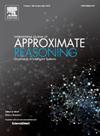基于迭代下界估计的不确定数据多步区间预测模型
IF 3
3区 计算机科学
Q2 COMPUTER SCIENCE, ARTIFICIAL INTELLIGENCE
引用次数: 0
摘要
对于复杂系统,大多数传感器数据存在偏差,导致多步预测结果精度较低。本文基于下上界估计(LUBE)方法,提出了一种适用于区间输入的多步迭代区间预测模型,既保持了原模型的简单结构,又实现了不同领域的单步和多步预测点(PP)和预测区间(PI)。首先,构造了具有区间输入和输出特征的迭代LUBE (ILUBE)网络结构;其次,根据该结构,重新定义了一组多步区间性能指标,提出了一种新的指标线性减小多步预测区间归一化中心偏差(LMPINCD)来衡量预测水平,并将其添加到多步覆盖宽度准则(MCWC)中。最后,由于MCWC是一个非解析函数,采用粒子群优化(PSO)元启发式优化算法寻找ILUBE模型的最优参数。利用实际风速和电力负荷数据对模型的性能进行了评价。实验结果表明,该模型在多步PI中优于所有其他基准模型,在多步PP中也取得了良好的效果。本文章由计算机程序翻译,如有差异,请以英文原文为准。

A novel multi-step interval prediction model for uncertain data using iterative lower upper bound estimation method
For complex systems, most sensor data are biased, resulting in low accuracy of multi-step prediction results. Based on the lower upper bound estimation (LUBE) method, this paper proposes a multi-step iterative interval prediction model suitable for interval input, which not only maintains the simple structure of the original model, but also realizes single-step and multi-step prediction point (PP) and prediction interval (PI) in different fields. Firstly, an iterative LUBE (ILUBE) network structure, characterized by interval-valued inputs and outputs, is constructed. Secondly, according to this structure, a set of multi-step interval performance indicators are redefined, and a new indicator linear decrease multi-step prediction interval normalized center deviation (LMPINCD) is proposed to measure the prediction horizon, which is added to the multi-step coverage width-based criterion (MCWC). Finally, because MCWC is a non-analytic function, the particle swarm optimization (PSO) meta-heuristic optimization algorithm is used to find the optimal parameters of the ILUBE model. The performance of the model is evaluated using real wind speed and power load datasets. The experimental results show that the model is superior to all other benchmark models in multi-step PI, and also achieves good results in multi-step PP.
求助全文
通过发布文献求助,成功后即可免费获取论文全文。
去求助
来源期刊

International Journal of Approximate Reasoning
工程技术-计算机:人工智能
CiteScore
6.90
自引率
12.80%
发文量
170
审稿时长
67 days
期刊介绍:
The International Journal of Approximate Reasoning is intended to serve as a forum for the treatment of imprecision and uncertainty in Artificial and Computational Intelligence, covering both the foundations of uncertainty theories, and the design of intelligent systems for scientific and engineering applications. It publishes high-quality research papers describing theoretical developments or innovative applications, as well as review articles on topics of general interest.
Relevant topics include, but are not limited to, probabilistic reasoning and Bayesian networks, imprecise probabilities, random sets, belief functions (Dempster-Shafer theory), possibility theory, fuzzy sets, rough sets, decision theory, non-additive measures and integrals, qualitative reasoning about uncertainty, comparative probability orderings, game-theoretic probability, default reasoning, nonstandard logics, argumentation systems, inconsistency tolerant reasoning, elicitation techniques, philosophical foundations and psychological models of uncertain reasoning.
Domains of application for uncertain reasoning systems include risk analysis and assessment, information retrieval and database design, information fusion, machine learning, data and web mining, computer vision, image and signal processing, intelligent data analysis, statistics, multi-agent systems, etc.
 求助内容:
求助内容: 应助结果提醒方式:
应助结果提醒方式:


